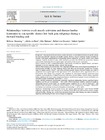| dc.contributor.author | Hemming, Rebecca | |
| dc.contributor.author | du Rose, Alister | |
| dc.contributor.author | Sheeran, Liba | |
| dc.contributor.author | van Deursen, Robert | |
| dc.contributor.author | Sparkes, Valerie | |
| dc.date.accessioned | 2023-11-14T10:57:16Z | |
| dc.date.available | 2023-11-14T10:57:16Z | |
| dc.date.issued | 2024-01 | |
| dc.identifier.citation | Hemming, R., du Rose, A., Sheeran, L., van Deursen, R., & Sparkes, V. (2024). Relationships between trunk muscle activation and thoraco-lumbar kinematics in non-specific chronic low back pain subgroups during a forward bending task. Gait & Posture, 107, 96–103. https://doi.org/10.1016/j.gaitpost.2023.09.018 | en |
| dc.identifier.issn | 0966-6362 | |
| dc.identifier.uri | https://aecc.archive.knowledgearc.net/handle/123456789/202 | |
| dc.description | Available under License - Creative Commons Attribution: https://creativecommons.org/licenses/by/4.0/ | en |
| dc.description.abstract | Background: Trunk muscle activity and thoraco-lumbar kinematics can discriminate between non-specific chronic low back pain (NSCLBP) subgroups and healthy controls. However, research commonly focuses on lumbar kinematics, with limited understanding of relationships between kinematics and muscle activity across clinical subgroups. Similarly, the thoracic spine, whilst intuitively associated with NSCLBP, has received less attention and potential relationships between spinal regions and muscle activity requires exploration.
Research question: Is there a relationship between trunk muscle activation and regional thoracic and lumbar kinematics in NSCLBP subgroups during a forward bending task?
Methods: Observational, case-control study. Fifty subgrouped NSCLBP motor control impairment participants (27 Flexion Pattern (FP-MCI), 23 Active Extension Pattern (AEP-MCI)) and 28 pain-free controls were evaluated using 3D motion analysis (Vicon™) and surface electromyography during a forward bending and return to upright task. Mean sagittal angles for the upper-thoracic (UTx), lower-thoracic (LTx), upper-lumbar (ULx) and lower-lumbar (LLx) regions were compared with normalised (% sub-maximal voluntary contraction) mean amplitude electromyography of bilateral transversus abdominis/internal oblique, external oblique, superficial lumbar multifidus and erector spinae (longissimus thoracis) muscles between groups. Pearson correlations were computed to assess relationships (significance p < 0.01).
Results: AEP-MCI individuals demonstrated statistically significant relationships between superficial lumbar multifidus and ULx and LLx kinematics (-.812 to.659). FP-MCI individuals exhibited statistically significant relationships between erector spinae and superficial lumbar multifidus and LLx and LTx kinematics (-.686 to.664) in both task phases, and between external oblique and LTx during forward bending) (-.459 to.572). Correlations were moderate to strong for all significant relationships (-.812 to .664).
Significance: Relationships between muscle activity and regional spinal kinematics varied between NSCLBP subgroups, suggesting that those with flexion- or extension-related LBP adopt different motor control strategies when performing a bending task. As effectively mechanical biomarkers, these findings may inform treatment by improving understanding of varied motor strategies in subgroups. | en |
| dc.language.iso | en | en |
| dc.publisher | Gait & Posture | en |
| dc.subject | Kinematics | en |
| dc.subject | Trunk muscle | en |
| dc.subject | Non-specific chronic low back pain | en |
| dc.subject | Muscle activity | en |
| dc.subject | Bending | en |
| dc.title | Relationships between trunk muscle activation and thoraco-lumbar kinematics in non-specific chronic low back pain subgroups during a forward bending task | en |
| dc.type | Article | en |
| dc.identifier.doi | https://doi.org/10.1016/j.gaitpost.2023.09.018 | |
